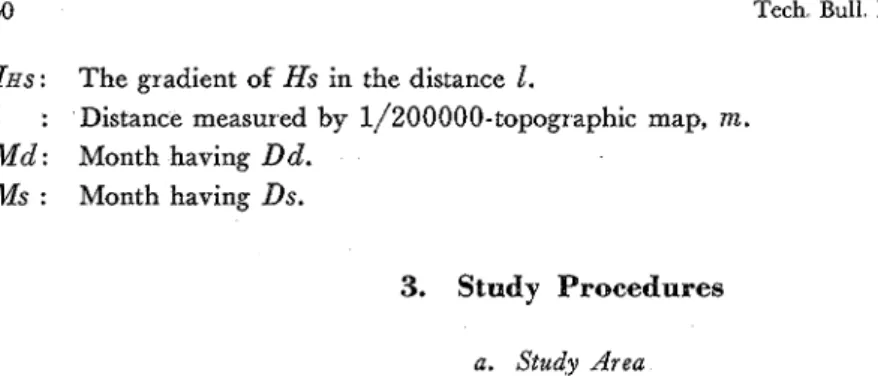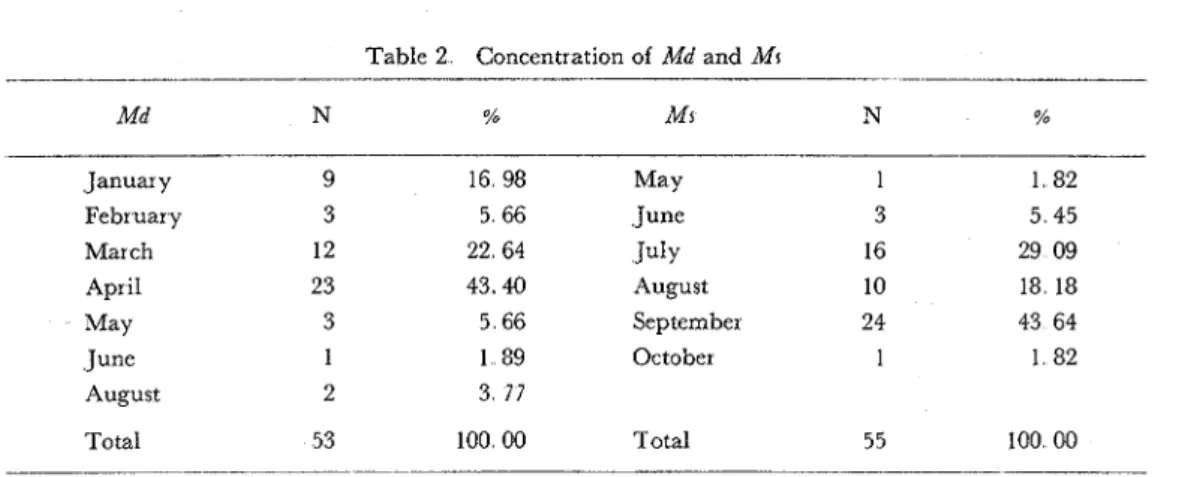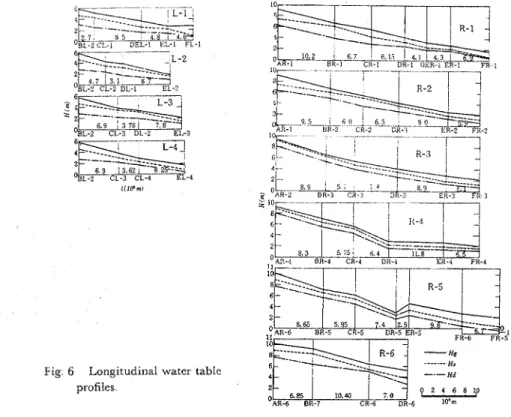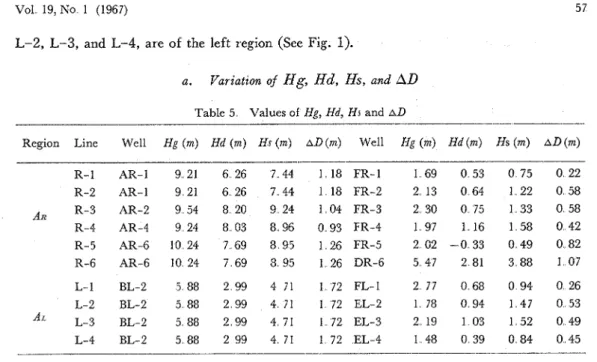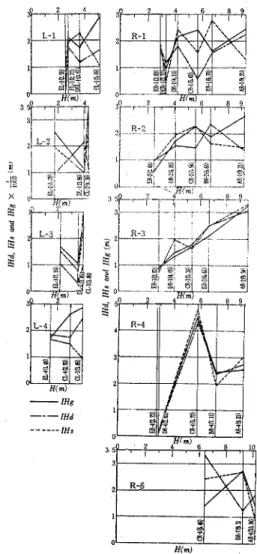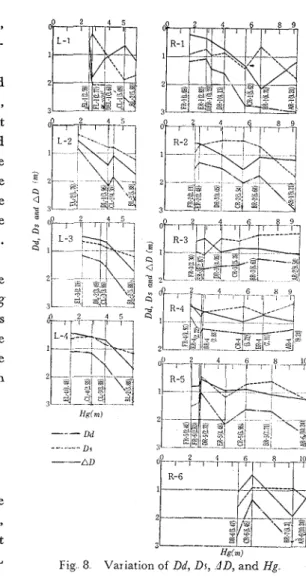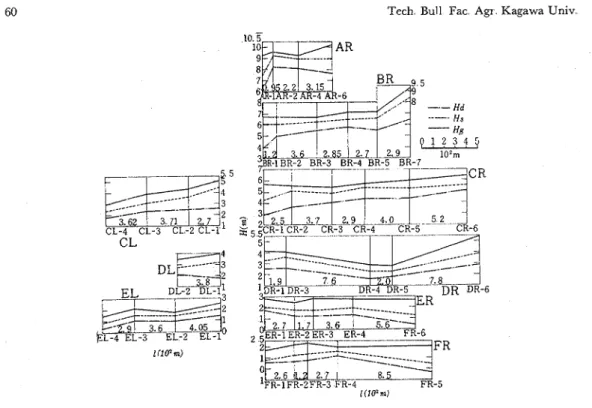(注意)この論文には正誤表があります
香川大学農学部学術報告 第19巻第1号 正誤表 URL
http://www.lib.kagawa-u.ac.jp/metadb/up/AN00038339/AN00038339_19_1_e.pdf
Notice
Technical Bulletin of Faculty of Agriculture, Kagawa University Vol.19 No.1 Errata
URL
Vol 19, No 1 (1967)
SHALLOW GROUND WATER IN T H E DOWNSTREAM
BASIN
OF T H E AYA RIVER, KAGAWA PREFECTURE
VI On the Characteristics of' the Belt of' Fluctuation of' the WaterTable During the Period from October 1964 to September 1965
Kiyoshi FUKUDA, Katsuhiko Izursu, and Tadao MAEKAWA
B. Introduction
The belt of the fluctuation of the water table, or the belt of phreatic fluctuation is a part of the lithosphere and it lies a part of the time in the overlying zone of areation(l2). For our case of a shallow-ground water, the belt of the fluctuation of the water table is a zone between the water table at the highest stage('') and the lowest stage.('')
For a given region or aquifer, the volume of the belt of fluctuation of the water table is generally expressed in ha-m or area-depth.
By multiplying this volume of the belt by the specific yield, the net amount of ground water can be approximately calculated for a given region or aquifer during a specific period of rise or during a specified period of fall"
Therefore, it is important to find out the characteristics of the belt of the fluctuation of the water table in the study area.
The report presented here is the result of our study with the above objective using the data obtained from our field i n ~ e s t i ~ a t i o n s . ( l ' ~ ~ ~ ~ ~ ~ ~ ~ )
2. Notation AL : Left region, 139. 5 8 ha.
AR : Right region, 492. 8 5 ha.
Aw
: Whole study area, 632. 4 3 ha.D d : The depth of the lowest stage of the water table or the deepest water table for the period from October 1964 to September 1965. The depth was measured from soil surface, m.
Ds
: T h e depth of the highest stage of the water table or the shallowest water table for the same period, mA D : The difference between Dd and Ds or Dd-Ds (therefore Hd-Hs), m
d : Well depth measured from soil sureface, m .
H : Altitude of ground-surface, m.
H d : Altitude of the lowest stage of the water table or the deepest water table, m.
H g : Altitude of the well sites, m.
Hs : Altitude of the highest stage of the water table or the shallowest water table depth, m.
Ilrd: The gradient of Hd in the distance 1 I H ~ : The gradient of H g in the distance 1.
50 Tech. Bull. Fac Agr. Kagawa Univ.
IHS
: T h e gradient ofHs
in the distance 1.1
: Distance measured by 1/200000-topographic map, m.M d :
Month havingDd.
Ms
: Month havingDs.
3.
Study
Procedures a. Study AreaAs reported in the previous paper(7), the study area was divided into two regions; 1) the right region
AR
calculated as 492. 85 ha and 2) the left region, AL calculated as 139. 58 ha as shown in Fig. 1.b. Longitudinal Water Table Profile T o make u p the longitudinal water table profile of the study area, we connected the observation wells along the Aya River irom the upper district to the lower district, and we made up six lines, R-1, R-2, R-3, R- 4, R-5 and R-6 for the right region, and four lines, L-1, L-2, L-3 and L-4 for the left region as shown by the solid lines in Fig. 1,
Fig 1 Study area and observation wells
c. Transversal Water Table Profile
T o make up the transversal water table profile of the study area, we conneced four obser- vation wells, AR-1, AR-2, AR-4 and AR-6 in the right region, and we made up line AR as shown by the dotted line in Fig. 1.
Similarly, we made u p more five lines, BR, CR, DR, ER, and FR as shown in the same figure. For the left region, we also made up three lines, CL, DL, and E L as shown in the same figure.
4. Results
and
Discussion 4. 1. Values of'Dd,
Ds,
andAD
4. 1. 1. Va1ue.s of'Dd,
Ds,
andAD
From the data obtained from our field investigation, we made up Table 1 which shown the values of
Dd,
Ds,
AD
for the period from October 1964 to September 1965.Vol. 19, No, 1 (1967) 5 1
Table 1. Values of Md, Dd, Mr, Dr, and AD
Well AR- 1 AR-2 AR-3 AR-4 AR-6 BR- 1 BR-2 BR-3 BR-4 BR- 5 BR-6 BR- 7 CR- 1 CR-2 CR-3 CR-4 CR- 5 CR-6 DR- I DR-2 DR-3 DR-4 DR- 5 DR-6 ER- I ER-2 ER-3 ER-4 ER- 5 FR- 1 FR-2 FR-3 FR-4 FR- 5 FR-6 BL-2 CL- 1 CL-2 CL-3 CL-4 DL- I DL-2 EL- 1 EL-2 EL-3 EL-4 FL- I DER- 1 DEL- 1 May 2 95 April 1 34 March, April 1 23 January 1 21 April 2 55 April 2 76 March, April 1. 71 January 1 18 April 1 38 January 1 65 February 0 82 May 2 85 June 2 73 April 1 99 April 1 40 Apr 11 1 36 April 1 58 August 1 33 March 1 59 February 1 70 April 1 46 March 1 24 January 1 01 March 2 66 March 1 08 April 1 27 January 1 58 January 1 35 February,March 2 14 January 1 16 Aprll 1 49 April 1 55 April 0 81 April 2 35 April 2 19 Aprll 2 89 January 2 54 April 1 85 April 1 56 April 1 15 April 2 17 March 1. 39 March 1 11 January 0 84 March 1. 16 May 1 09 March 2 09 March 1 43 April 2 06 September July .July September July, August August August September September September September September September August August, September July September September September July, August August July Septembel July July September June June, October September September July September September July ,June July August ,July, September August July September September July August September September September
52 Tech. Bull.. Fac Agr.. Kagawa Univ.. From Table 1, we made up Table 2 which shows the concentration of M d and
Ms
dur- ing the period from October 1964 to September 1965.Table 2 Concentration of Md and Mr
January February March April May June August Total 16 98 May 1 5 66 June 3 22 64 July 16 43 40 August 10 5 66 September 24 1 89 October 1 3 7 7 100 00 Total 55
There were 5 3 M d during the period from October 1964 to September 1965: 23 (43. 40 per cent) were in April, and 1 2 (22.64 per cent) were in March. Thus, 66.04 per cent occurred in the months of April and March. As a whole, the lowest stage of the water table or D d occurred in ~ ~ r i l ( ~ ) .
Similarly, Ms was concentrated in September (43.64 per cent) and July (29.09 per cent). Thus, as a whole, the highest stage of the water table or Ds occurred in ~ e ~ t e m b e r ( ~ ) .
b. Distribution of D d , Ds, and A D
Through the period fiom October 1964 to September 1965, the values of' D d varies from 0.81 m (FR-4 in April) to -2.95 m (AR-1 in May), Ds varies fiom 0..28 m (AR-4 in September) to 1.83 m (FL-1 in September), and A D varies from 0..22 m (FR-1) to 2.15 (BR-1) as listed on Table 3..
Table 3 Maximum and minimum values of Dd, Dr, and A D
Dd (m) D f (m) A D (m)
Max Min Max Min Max Min
-Value 2 95 0 81 1 83 0 28 2 15 0 22 Well AR- I FR-4 FL- 1 AR-4 BR- I FR- 1
Month May April September September
.4.. 1.. 2. Relation.ship between D d , Ds, A D , and d , and
Hg
a. Relationship between D d and
Hg
T o find out the relationship between D d and
H g
for the study area, we drew up three graphs as shown in Figs. 2-R (right region), 2-L (left region), and 2-W (the whole study area). The ,y-axes are the values of' the dependent variable D d , and the .x-axes are the independens variableHg.
Vol. 19, No 1 (1967) 53
Fig 2. Relationship between Dd and Hg.
There are various methods of determining the line which best fits the given points. W e used the one which is most widely used: the method of least squares(16).
In our case, for the data shown in Fig. 2 ( R , L, and W ) , the equation of the least-squares line is
and this can be found b y the values
and
a = ~ d - - a 2 2
(1.3).Using Eqs.. (1.2) and (1.3), we calculated the data shown in Fig.. 2-R, and we calculated the values,
a=
- 0.0263, and a= 1.806. W e put these values into Eq. (1.1),then we obtained Eq. (2). This is the line indicated in Fig. 2-R.
Similarly, from the data in Fig. 2-L, we obtained
a=
0.4332, anda=
0.220,and then we obtained Eq. ( 3 ) which is shown as the line in Fig.. 2-L.
Also from the data in Fig.. 2-W, we calculated the values,
a=
0..00696, and a= 1..640,and then we obtained E q . ( 4 ) which is shown as the line in Fig. 2-W.
The results obtained from the calculation by using Eqs. ( 2 ) and ( 3 ) show that as the values of
Hg
increase frnm 0.0 to 6.0 m the values of D d decrease from 1.81 to 1.68 m in the right region whereas the values of D d increase from 0 22 to 2.82m in the left region.54 Tech Bull Fac Agr, Kagawa Univ Using Eq. (4) for the whole study area, Dd increases from 1.64 to 1.68 m as
Hg
increases from 0.0 to 6.0m. These data are listed on Table 4.Table 4 Calculated values of Dd, Ds, AD, and d
b. Relationship between D s and
Hg
Fig. 3 (R, L, and W) shows the relationship between D s and
Hg:
For the right region (Fig. 3-R), for the left region (Fig. 3-L), and for the whole study area (Fig. 3-W).Fig 3 Relationship between D I and Hg
For the figures, the equation of the least-square line is
From the data in Fig. 3-R, we obtained
/3=
-0.0184 and b=0.911 by using Eq. (5), and then we made up Eq. (6). This is the line indicated in Fig. 3-R.Similarly, we obtained Eq, (7) from Fig. 3-L, and Fq. (8) from Fig. 3-W. (Ds) L = 0.0878
H g
+
0.528 (7) (Ds)w=
- 0.0105Hg
$0.868 (8).These are shown as the lines in Fig. 3-L and Fig. 3-W respectively.
The values of D s decrease slightly from 0.9 1 to 0.80 m as
Hg
increases from 0.0 to 6.0 m in the right region. The values of D s increase from 0.53 to 1.06 m in the left region. As a whole, D s decreases from 0.87 to 0.81m asHg
increases from 0.0 to 6.0m for the whole study area. These data are listed on Table 4.Vol 19,No I (1967) 55
c. Relatzonship between A D and
Hg
Fig. 4 . Relationship between AD and Hg
For Fig. 4 ( R , L, and W ) which shows the relationship between A D and
Hg,
the equation of the least-square line isUsing Eq. ( 9 ) , we calculated the data in Fig. 4-R and we obtained Eq. ( l o ) , as shown by the line that is in the figure.
Similarly, from Fig. 2-L we obtained Eq. ( 1 1 ) as shown by the line in the figure, and Eq. (12) from Fig. 2-W
( A D )
w
= 0.0986Hg+ 0.394 (12).As
H g
increases from 0.0 to 6.0m, the values of A D increase from 0.38 to 0.93m in the right region and from - 0.31 to 1.77 m, in the left region.As a whole, A D increases from 0 39 to 1,OOm as
Hg
increase from 0 0 to 6.0 m for the whole study area. These data are listed on Table 4.d. Relatzonship between d and
Hg
Fig 5 Relationship between d and Hg
Fig. 5 (R, L, and W) shows the relationship between d and
Hg,
For this figure, the equa- tion of' the least-square line is56 Tech Bull Eac Agr Kagawa Univ
- ---
H g d - H g d
I
6=
--2H g 2 - %
and we obtained Eq. (14) fox the right region, and Eq. (15) for the left region and Eq. (16) for the whole study area.
As the values of
Hg
increase from 0.0 to 6.0 m, the values of d increase from 2.25 to 2.87m in the right region, from 1.31 to 3.72m in the left region, and from 2.19 t o 2.91m in the whoie study area. These data are listed on Table 4.4. 2. Water Table Profile
4. 2. 1. Longitudinal Water Table Profile
Fig. 6 shows the longitudinal water table profile of' the study area. In this figute, six graphs, R-1, R-2, R-3, R-4, R-5, and R-6, a r e of' the right region and four graphs, L-1,
._
I(1ff.J
Fig. 6 Longitudinal water table pr.ofiles
Vol 19,No 1 (1967)
L-2, L-3, and L-4, are of the left region (See Fig. 1).
a. Variation of
Hg, Hd, Hs,
and AD Table 5 Values of Hg, Hd, Hr and A D.- ---
Region Line Well Hg (m) Hd (m) Hr (m) AD (m) Well Ng (m) Hd (m) Hs (m) AD (m)
Rzght Regzon. From the graphs, R-1, R-2, R-3, R-4, R-5, and R-6, it is clear that the values of
Hg, Hd, Hs,
and AD decrease from the wells of the upper district's (on the left side of each graph) to the wells of the lower district's (on the right side of each graph). The values ofHg
decrease from 9.21 -- 10.24 m to 1.69-
5.74 m. The values ofHd
decrease from 6.26 - 8.20 m to - 0 33 m (below sea level)-
2.81 m, the values ofHs
decrease from 7.44-
9.24 m to 0.49-
3.88 m, and AD decrease from 0.93-
1.26 m to 0.22 - 1.07 m. These values are listcd on Table 5.L e f t Regzon: As shown in graphs L-1, L-2, L-3, and L-4, the values of
Hg, Hd, Hs,
and
AD
decrease from the wells of the upper district to the wells of the lower district. The values ofHg
decrease from 5 88m (BE-2) (on the right side of the graphs) to 1.48- 2.77m (on the left side of the graphs). The values ofHd
decrease from 2.99m (BL-2) to 0.39-1.03 m the values ofHs
decrease from 4.71 (BL-2) to 0.84-1.52 m, and the values ofAD decrease from 1.72 m (BE-2) to 0.26 - 0.53 m. These data are listed on Table 5. b.. Variation of
IH g, I H
d , andIHS
TO see if the line of'
Hs
is parallel to the line of'Hd
in Fig. 6, we introduced the following thr.ee equations ;(18), and
58 Tech Bull Fac Agr Kagawa Univ in Fig. 6, and the results are shown in Fig. 7.
Fig. 7 also shows the relationship between k g , I H ~ , and
IHS.
Five graphs, R-1, R-2, R-3, R-4, and R-6 are for the right region, and four graphs, L-1, L-2, L-3, and L-4 are for the left region.As shown in Fig. 6 (line R-1), line H s is not parallel with either line Hd or line H g : thus, line I H ~ , I H ~ , and
IHS
are not parallel as shown in Fig. 7 (R-1). As shown in Fig. 1 , line R-1 runs along the right side of the Aya River, thus, the variations are influenced by the river. The water level of the river fluctuates greatly in the irrigation period, therefore line H d , the lowcst stage of the water table, does not parallel line Hs, the highest stage of the water table, whereas line Hd is parallel to line H g , (the altitude of the well sites) as shown in Fig. 7 (R-1).Graph R-2 shows that three lines, I H ~ , I H ~ , and IHS, are roughly parallel to each other. As shown in Fig. 1, R-2 is further away from the Aya River than line R-1. Therefore, the in- fluence of the river on the water table is smaller.
Graph Pi-3 and R-4 show that I H ~ , I H ~ , and
IHS
are parallel to each other As shown in Fig. 1 , lines R-3 and R-4 run through the middle of the right region from the upper to the lowcr districts, thus, the influence of the river is very small. From the shape of the two lines,HfmJ
Flg 7 Relationsh~p between IHd, IHr, and R-3 and R-4 shown in Fig. 7, the following are IHe
-
made clear : 1 ) the water table at the highest stage is parallel to the ground-surface, 2) the water table at the lowest stage is also parallel to the ground-surface, and 3) the gradient of H g , H d , and Hs or I H ~ , I H ~ , andIHS
decrease roughly as the altitude of ground surface ofH
decreases.c. Variation of D d , Ds, and A D and
Hg
Fig. 8 shows the variation of D d , Ds, and A D and
Hg
for the period from October 1 9 6 4 to September 1965. Graphs R-1, R-2, R-3, R-4, R-5, and R-6 are for the right region, and L-1, L-2, L-3, and L-4 are for the left region.Rzght Region: In graph R-3, the value of A D is about 1,0 m between AR-2
(Hg=
9 . 5 4 m ) and DR-3 (Hg=4.05m). In graph R-4, the value of A D is also about 1.0m between AR-4Vol 19, No 1 (1967) 59
district to the middle district (See line DR), the values of AD are roughly 1.0 m every- where.
Between wells ER-3
(Hg=
2.87 m ) and FR-3 (Hg=2.30 m) shown in graph R-3, the values ofAD
are about 0.5m. And at the two wells ER-4 ( H g 2 . 7 2 m) and FR-4 ( H g = 1.97 m), the values ofAD
arealso 0.5m. Wells on lines ER and FR are
'
distributed over the lower district or theregion and most of them are along the coast of the Inland Sea as shown in Fig. 1.
L e f t Regzon: In graph L-3, the value of AD is about 0.5m between CL-3
( f i g
= 3.89 m) and EL-4
(Hg=
1.48 m). Wells CL-3, CL-4, DL-3, EL-2, and EL-4 are in the rice fields of the region near the coast of the Inland Sea as shown in Fig. 1.4. 2. 2 T r a n ~ v e r s a l W a t e r T a b l e P r o j l e -.
-
Dd-- -. DI
-AD
a. Va7zatzon of H g , H d , and
HS
Fig. 9 shows the transversal water table profile of the study area. Six graphs AR, BR, CR, DR, ER, and FR are for the right
Hsirn)
region and three graphs CL, DL, and E L Fig 8 Var~atlon of Dd, Dr, 4D, and Hg are for the left region.
Rzght regzon: In the three graphs, AR, BR, and CR, the values of
Hg
decrease from right side to the left side of the figure. The right side corresponds to the district near the mountain and the left side to the district close to the Aya River as shown in Fig. 1.In the two graphs, BR, and CR,
Hd
and H s decrease from the mountain side to the river side. T h e shallow ground-water in this part goes into the Aya River. The Aya River in this part is effluent stream(13) with respect to the shallow ground-waterIn the graph DR, lines H g , Hd and
HS
form a valley at two wells, DR-4 and DR-5, in the middle of this water table profile.From this, in this part of the region, the shallow ground-water goes into the Kamidant River as shown in Fig. 1. This was inferred from the contour lines of the study area made up in the f i r d 2 ) and the third reports(6) of this study. Also, from thc two graphs, E R a n d FR, the shallow ground-water goes into the Kamidani River.
According to the two contour-line maps shown in the third report (one based on the irriga- tion period average and the other based on the non-irrigation) the contour lines are similar in shape, thus, the shaiiow ground-water of this area goes into the Kamidani River through-
Tech Bull Fac Agr Kagawa Univ
Fig 9 Transversal water table profiles
out the year The Kamidani River in this area is effluent stream with respect to the shallow ground-water
L e f t Regzon: On all of the graphs, CL, DL, and EL, the values of H g decrease from the right side to the left side, The right side is the river side and the left side is the sea side as shown in Fig 1. The profiles of H d , and Hs also decline from the river side to the sea side.
b. Variation of D d , Ds, and A D
Fig. 10 shows thc variation of D d , Ds, and A D on the transversal water table profile of the study area. Six graphs, AR, BR, CR, DR, ER, and FR are for the right region, and three graphs, CL, DL, and E L are for the left region.
R i g h t Region : The values of D d decrease from the profile AR to profile FR D d decreases from the upper district to the lower district of the region. On the other hand, the values of Ds increase from the profile AR to profile FR, thatis Ds increases from the upper district to the lower district. Thus, the values of A D or Dd-Ds, decrease from the upper district to the lower district.
From profile AR to profile CR, the values of A D are about 1 Om below the ground surface whereas they are about 0.5 m below the ground surface from piofile DR to profile FR.
As shown in Fig. 1, the three profiles, AR, BR, and CR, are in the upper part of the right region, and the rest, DR, ER, and FR, are in the lower part of the region : thus, differences between the highest and the lowest stages of the water table ( = A D ) are about 1.0m in the upper region and 0.5 m in the lower.
The large values of D d , and
Ds
occur along the areas near the riper and the mountains. Wells AR-6, BR-7, DR-6, and ER-5 are located along the mountain range and the valuesVol 19, No 1 (1967)
Fig 10 Variation of Dd, Dr, and 4 D
of D , and Ds in these wells are large. Wells AR-1, BR-1, and CR-1 are located along the right side of the Aya River, and well FR-6 is located near the left side of the Kamidani River, thus, the values of D d , and Ds in these wells are large.
However, the values of D d and Ds are small in wells DR-1, ER-1, and FR-1 although these wells are located along the right side of the Aya River This is due to the fact that the water flows into the river in this area(14).
Left Regzon: Three graphs, CL, DL, and E L show that the wells located on the river side have large values of D d and AD. In graph EL, the values of D d , Ds, and A D are roughly constant; D d is about 1 Om, Ds and A D are about 0.5m. Wells on the profile are located on the lower part of the region (near the coast of the Inland Sea as shown in Fig. 1).
5. Summary
T o find out the characteristics of the belt of fluctuation of the water table during the period from October 1964 to September 1965, we made u p the longitudinal and transversal profiles of the water table of the study area by using the data obtained from our field investigations, The method we used and the results of the study are as follows:
T o find out the relationship between D d and
Hg,
we used the Least-Squares Method and we obtained three linear equations; Eqo (2) for the right region, Eq. (3) for the left region, and Eq. (4) for the whole study area. The result of the calculation was that the values of D d increased from 1 6 4 to 1 6 8 m as the values ofHg
increased from 0 0 to 6.0m in the whole study area.Similarly, we obtained three linear equations, Eqs. (6), (7), a n d (8), to see the relationship between Ds and
H g
Using these equations we found that the values of Ds decreased from 0.87 to 0.81 m as the values ofHg
increased from 0 0 to 6.0 m in the whole study area.For the values of A D and
Hg,
we obtained Eqs. ( l o ) , (ll), and (12) Using these equa- tions we found that the values of A D increased from 0.39 to 1.00 m as the values ofHg
62 Tech Bull Fac Agr Kagawa Univ
For the values of
d
andHg,
we formulated three equations Eqs. (14), (15), and (16). Using these equations we found that the values ofd
increased from 2.19 to 2.91 m as the valuesH g
increased from 0.0 to 6.0 m in the whole study area.As shown in Fig. 1 , we made u p ten longitudinal lines of the study area connecting wells, R-1, R-2, R-3, R-4, R-5, and R-6 for the right region and L-1, L-2, L-3, and L-4 for the left region. Following these lines, we made up ten longitudinal profiles for each of the following water tables,
D d , Ds,
andA D
as shown in Fig. 6.W e also made u p nine transversal lines of the study arca connecting the wells as shown in Fig. 1 , AR, BR, CR, DR, ER, and FR for the right region and CL, DL, and E L for the left region. Following these lines, we made up nine transversal profiles for each of the following water tables,
D d , Ds
andA D
as shown in Fig. 9.The lowest stage of the water tables occurred 5 3 times in seven months of which 43.40 per cent occurred in April. The shallowest stage of the water tables occurred 5 5 times in six months of which 43. 6 4 per cent occurred in September.
T h e maximum value of the lowest stage of the water tables was 2.95m (AR-1, May) and the minimum value was 0 8 1 m (FR-4 April). For the shallowest stage of the water tables, they were 1.83m FL-1, September) and 0.28m (AR-4, September), and for the distance between the lowest and the shallowest stages, they were 2.15m (BR-1) and 0.22m (FR-1).
T h e writers wish to thank Former Professor Dr. Hitoshi FUIWDA, and Associate Professor Dr. Hiroyuki OGATA both of Tokyo University for their encouragement.
A part of expenditure was from the research fund donated by the Ministry of Education.
References
(1) FUKUDA, K , OCHI, T , KONO, Y , SHIIKI, K , NARUHIRO, 'ISHIMONO, , S : Shallow-Ground Water in the Downstream Basin of the Aya River, I, Tech Bull Fac Agr Kagawa U n z u , 17, 29-35 (1965)
(2) FUKUDA, K , OCHI, T , I ~ O N O , Y
,
MAEKAWA, T , SHIIKI, K , NARUHIRO, T , SHIMONO, S :zbzd, 11, 32 (1965)
(3) FUKUDA, K ,NAGANO, T ,OCHI , T , MAEKAWA, T : Shallow-Ground Water in the Down- stream Basin of the Aya River, 111, T e ~ h Bull Fac Agr Kagawa Unzv
,
18, 54-65 (1966)(4) FUKUDA, K , NAGANO, T ,OCHI, T
,
MAEKAWA, T : t b z d , 18, 60 (1966)(5) FUKUDA, K , NAGANO, T , &HI, T
,
MAEKAWA, T : t b z d , 18, 60 (1966)(6) FUKUDA, K , NAGANO, T , &HI, T, MAEKAWA, T : tbzd, 18, 63-64 (1966)
(7) FUKUDA, K , NAGANO, T , MAEKAWA, T : Shallow-Ground Water in the Downstream Basin of the Aya River, IV, Tech Bull Fac
Agr Kagawa Unto 1 8 , 186-187 (1967)
(8) FUKUDA, K
,
NAGANO, 'I, MAEKAWA, T :zbtd, 18, 186-207 (1967)
(9) FUKUDA, K : Shallow-Ground Water in the Downstream Basin of the Aya River, V, Tech
Bull Fa6 Agr Kagawa Unto ,18,208-209 (1967).
(10) MEINZER, 0 E : Outline of Ground-Water Hydrology, 35, Government Printing Office, Washington (1923)
(1 1) MEINZER, 0 E : zbtd , 35 (12) MEINZER, 0 E : t b t d , 35-36 (13) MEINZER, 0 E : zbzd, 56 (14) ~ / I E I X Z E R , 0 E : t b t d , 56
(1 5) OCHI, T
,
FUKUDA, K,
AOKI, 7 : Shallow- Ground Water in the Downstream Basin of the 4ya River, 11, Tech Bull Fac Agr KagawaUntu
,
17, 42-49 (1965)(16) W A S H I I L G ~ O ~ , A : Basic Technical Mathe- matics with Calculus, 330-331, Addison- Wesley Publishing Co , Inc
,
London (1965)Vol. 19, No 1 (1967)
Ql1l-F
%%a
tz
8
tlf-
b
&E&'F'7k
VI 1 9 6 4 + 1 o ~ ; s ~ 1 ; 1 9 6 5 q 9 a t ~ ~ a r ~ ~ 1 2 k a i r . a j . v a Belt of' fluctuation D@@i'C-> l l '-C
Belt of fluctuation dj 5 l rid: Belt of phreatic fluctuation it Lithosphere ~ - - 2 $ T d j 5 hr, Z D6JfRTd2, Z.&% Dd (BR&7;7JUW.) t: Dr (@g&T7j~{$,) ~ f i i j ~ ? $ * t : L?:,, 5 2. h & f i & @ o Belt of fluctuation DgCb, --,&CZ, i l i j @ i % F d t @ T Z S h 6 ,, L?:;t)r,7T, ZD%9.B%.%6 Z k l t , e ~ % @ D . & l i & ' T 7 k % . i i m c z ~ ~ ~ - g - , j 2 , b z + . a r a l 9 g . % . x 6 . ,
e
ZT1964@10fl->1965@9 a ~ g R B u B e t C z & t : ~ + t > - c g t f i g , % + . 7:. $ 6 # l . g ~ f ? i i 4 4 C z Z ~ & i ' d . ~ ~ ~ & j T d j 5 . 1) $ T , Dd, Dr, .4D (= Dd- Dr) 3sit
20 ( ~5tlfi1.. Dd C;4 0 81-2. 95772, Dr it 0. 28-1 83m,e
L T AD 12 0 22-2. 15m2,
h>7Ld (3 D E l a . Z f - (Table 3)., 2) 9 + C t , Ddt:
D r h l X % T 5 8 l t , 2~8;t,l. Dd it 1, 2, 3, 4, .5, 6 B k i 3 8 a ~ 7 ~ E l i c h 7 : , 7 T X % T 6 h r , % a 4 3 40%Ct 4alZffZb&5.. Dr i t , 5, 6, 7, 8, 9 B d r U ; l O f l l ~ b f : ~ T X % T 6 h 1 : , 9 f l , Z i t , +%D43. 64%;bf1Yi5?, LTL > 6 (Table 2),,3) Dd, Dr, AD %& U; d (@&lijft-$~@S) fil Hg (N,+.D@&) @ @ ( L ~ L # ~ J ,7T 2 j E&$5 $3. Dd
&@$& Hg B.&HK
t:
4,
Table 1,2 ) Z Z T data 6. plot $6t:
Fig 29.j#5&2, c..;hh>G Dd-Hg h.@WDf:&5lZ-,&?CT g h f ., Least-squares method IZk ->T, Eqs. (2), (3), Bdr U; (4) %.j+f:. Z&cZ & 6t:,
!&i&&%k L T i t , Hg 0 0-6.Om & E @ F 5 r E j I z , Dd 1% 1 64.-1.68m T & s .ISl&lZ, Dr
t:
HsDBOQC~ Fig. 3 7 5 6 Eqs. ( 6 ) , ( 7 ) , B k 0 ( 8 ) T b h . @ 6 . Z & K k 6 t , H g h l 0 . 0 - 6 O m t:%@TQpk!!CZ Dr Ct0 87--0 81 m T d j 5 . .ADt:
Hg 8 # i % i b , Fig 4 a l h , Eqs (lo), (ll), B d r 0 (12) T?j?S&6., Z&bZCL&5t:,
Hg f j S O 0-6 Om t:A@ih'f-QPdCZ, AD (2 0.39-1 OOm T & s . dt:
Hg cZ.->t>Tct, Fig. 5 h.5 Eqs (14),(15), Bdr'cli'(l6)%~f%i$fi. L & / Z & 52,
Hg 530. 0-6.Om tABfi.z?Z5A (2, d (2 2. 19-2. 91 m t:f&'6,,4) i&i&D&llJ,+:%,#l&fj $iibZ.&$& L T 10 # € & $ $ & f p (3, Dd, Ds %& U; .4D 0 profiles 7: (Fig. 6),.
R
&IC 9 $i@&Ug.flr4,
Dd, Dr, Bk U: .AD profiles 7: (Fig 9),,Z cG~RCCC~, 3;C%Q1:4YHRi,d ($$Z6JfSf.R
